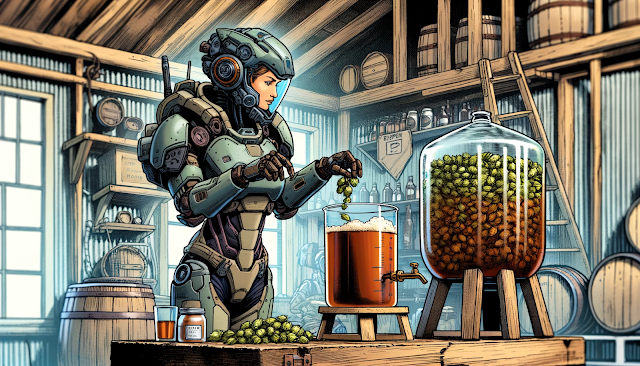In the verdant fields of the Pacific Northwest, a hop variety was born that would dramatically alter the landscape of craft brewing - the Citra hop.
This variety, known scientifically as HBC 394 cv., emerged not just as a new ingredient but as a cultural phenomenon, a defining flavour that powered the rise of the modern IPA.
The story of Citra hops is a tapestry woven with threads of agricultural science, brewing artistry, and market forces. It’s a tale of how one hop, with its explosive tropical fruit character, captured the imagination of a generation of brewers and beer lovers alike, cementing its place as one of the most important and sought-after hops in the world.
This guide is a deep dive into the world of Citra. We'll explore its origins, dissect the science behind its signature aroma, and provide a comprehensive playbook for maximizing its potential in your own home brewery.
Origin and Development
The genesis of Citra hops dates to a breeding program by the Hop Breeding Company, a joint venture between John I. Haas and Select Botanicals Group. Officially released in 2007, its genetic lineage is a complex mosaic including Hallertau Mittelfrüh, Tettnang, and East Kent Golding. This diverse background endowed Citra with a unique combination of intense aroma and solid agronomic traits.
Its ascent was meteoric. Pioneering craft breweries like Sierra Nevada, Russian River, and Three Floyds were early adopters, showcasing its explosive character in their beers.
The success of these beers created a massive demand, transforming Citra from a niche experiment into a global brewing superstar by the early 2010s.
The Science Behind the Aroma
Citra's distinctiveness lies in its chemical makeup. While it boasts a high alpha acid content (11-13%) for clean bittering, its soul is found in its essential oils and aroma compounds:
- High Myrcene Content: This terpene is the primary driver of the potent citrus (grapefruit, lime) and tropical fruit aromas.
- Geraniol and Linalool: These compounds contribute softer floral and fruity notes, adding layers of lychee and passionfruit complexity.
- Bound Thiols: This is Citra's secret weapon. During fermentation, certain yeast strains can unlock these "bound" sulfur compounds, releasing incredibly intense notes of passionfruit, guava, and mango that are not present in the raw hop itself.
Brewer's Insight: Biotransformation
The interaction between yeast and hop compounds like geraniol and bound thiols is known as biotransformation.
It's why adding Citra during active fermentation (a technique known as "dip hopping" or "active dry hopping") can create a different, often more intense, tropical character than adding it to finished beer.
This is advanced brewing chemistry in action in your fermenter!
Hot Side vs. Cold Side Applications
To truly master Citra, you must understand how to use it on both the hot side (during the boil/whirlpool) and the cold side (dry hopping).
- Boil Additions (Bitterness): Due to its high alpha acids, a small addition at the start of the boil (60 minutes) provides a clean, smooth bitterness. Use sparingly here to let the aroma shine later.
- Whirlpool/Steep Additions (Aroma & Flavor): This is where Citra truly shines on the hot side. Adding a large charge of Citra after the boil is complete, while the wort cools (ideally between 160-180°F or 71-82°C), extracts a massive amount of its aromatic oils without adding significant bitterness.
- Dry Hopping (Intense Aroma): Adding Citra to the fermenter after fermentation is complete is the key to the classic, in-your-face Citra aroma. This technique captures the most volatile compounds, resulting in a beer that explodes with tropical fruit notes from the moment you open it.
Advanced Techniques & Recipe Formulation
Pro-Tip: Water Chemistry for IPAs
To make your Citra hops pop, adjust your brewing water. Target a sulfate-to-chloride ratio of 2:1 or even 3:1.
Sulfates accentuate hop bitterness and create a drier, crisper finish, while chloride enhances malt character and mouthfeel.
For a classic West Coast IPA, aiming for 150-200 ppm of sulfate and 50-75 ppm of chloride is a great starting point.
- Yeast Pairing: The choice of yeast is critical. For a clean canvas that lets the hops shine, use a neutral American Ale strain (like Wyeast 1056 or SafAle US-05). For a hazier, fruitier expression that leverages biotransformation, use a dedicated "Hazy IPA" or English Ale strain with high biotransformation potential (like Wyeast 1318 London Ale III).
- Malt Balance: Citra is a superstar that doesn't need a complex malt bill. A simple base of 80-90% pale malt with a small amount of light crystal malt (for color and a touch of sweetness) or some oats/wheat (for haze and body in a NEIPA) is all that's required to support the hop character.
- Complementary Hops: While fantastic on its own in a "SMaSH" (Single Malt and Single Hop) beer, Citra plays exceptionally well with others. Pairing it with Mosaic adds complex berry and dank notes. Combining it with Simcoe introduces a resinous pine character for a classic West Coast profile. Blending with Amarillo enhances the orange and citrus notes.


